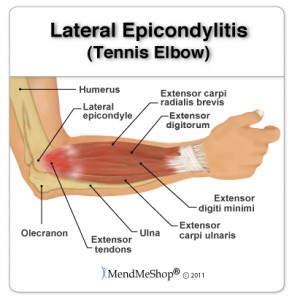Ask the Doc: Elbow Pain By Dr. Vince DiSaia
By Dr. Vince DiSaia
Ask the Doc, is a Boulderng Portal section dedicated to bouldering and climbing injuries, prevention and treatment. We will take a user injury submission and address it’s cause and possible plan for recovery.
If you have a tweak, pain or just want to stay healthy send us your submission and we will try to address each one.
Q: I have been battling with elbow pain for months and I cannot seem to get it to go away. I recently aggravated it campusing and now I am in much more pain. I have a bunch of friends complaning about the same injury, what is going on Doc?
 A: The elbow is a very common site for injury. If the pain is located directly on or immediately next to the bone on the outside of the elbow then you most likely have “tennis elbow”. While this is the common terminology, the medical term for the injury is lateral epicondylosis. The reason this is such a common injury is that many of the muscles that control the forearm and hand attach to this bone. Overuse or excessive load to these structures can cause scar tissue to build up within the muscles and tendons. As this scar tissue accumulates it effectively makes the muscles shorter and less elastic. This in turn increases the stress that is placed on the attachment point – in this case the outside part of the humerus. The consequence is pain not only in the damaged tissues, but also at the bony attachment. This injury can be extremely limiting and simple things such as lifting a coffee cup can become painful.
A: The elbow is a very common site for injury. If the pain is located directly on or immediately next to the bone on the outside of the elbow then you most likely have “tennis elbow”. While this is the common terminology, the medical term for the injury is lateral epicondylosis. The reason this is such a common injury is that many of the muscles that control the forearm and hand attach to this bone. Overuse or excessive load to these structures can cause scar tissue to build up within the muscles and tendons. As this scar tissue accumulates it effectively makes the muscles shorter and less elastic. This in turn increases the stress that is placed on the attachment point – in this case the outside part of the humerus. The consequence is pain not only in the damaged tissues, but also at the bony attachment. This injury can be extremely limiting and simple things such as lifting a coffee cup can become painful.
Since pain can be generated with the most basic uses of the hand/forearm, tennis elbow can be quite difficult to overcome. The quickest road to recovery should include soft tissue therapy to heal the damaged tissues. This allows normal, healthy tissue to replace injured tissue which makes the area stronger and more resilient to further use. Therapy may also include things such as ultrasound, joint mobilizations, functional taping, basic stretches, and potentially basic exercises. The biggest trick is to allow the area enough time to heal without repeated irritation. However, if the injury is severe then you may be re-aggravating the area dozens of times each day just by performing the simple tasks of day-to-day living. Every time you use the arm and feel pain in the area, you are mildly re-irritating the injury and slowing recovery time.
The million-dollar question that athletes always ask is, “Do I have to stop training?”. I am a big fan of keeping up with as much activity as possible without further damaging the area or significantly slowing down healing time. Your best guideline is pain. If climbing causes a significant increase in pain either during or after activity then you are further damaging the area and preventing healing. There is no black-and-white answer to this question so you must be hyper-aware of what you feel and whether the pain is changing in either intensity or frequency.
A forearm brace may be a good, temporary option to keep you from irritating the area throughout the day and allow more healing time. You can also try wearing it during climbing if you find that is significantly reduces pain. However, as soon as you find that an activity is pain-free without the brace then you need to stop wearing it for that particular activity. Strength in the forearm muscles needs to be built up again and wearing the brace prevents this from happening.
Other things that you may want to consider trying are natural, homeopathic anti-inflammatory creams. They can help naturally reduce painful inflammation and create an environment more suitable for healing. Supplementing with various vitamins, minerals, enzymes, and/or other products may also help optimize the body’s environment, but these are specific to each person and must be guided by a health professional.
While some people can get away with just ‘waiting it out’, many times these injuries need to be treated aggressively for full recovery and to prevent it from re-occurring in the near future. The sooner you address it, the sooner you can be back climbing with no pain and improved strength. Always remember that the goal is to get the body in a position where you can perform your best. Pain and damaged tissue will only hold you back from improving your climbing skills.
For more information on Dr. Vince or his clinic visit www.MomentumSportsTherapy.com or contact him directly at [email protected].
Category: Ask the Doc, Blog, Injuries











